How Is Doppler Radar Used In Meteorology?
Radar basics and the doppler shift
NEXRAD (Next Generation Radar) obtains weather data (atmospheric precipitation and wind) based upon returned free energy. The radar emits a flare-up of energy (dark-green in the animated image). If the free energy strikes an object (pelting drop, snowflake, hail, bug, bird, etc), the energy is scattered in all directions (bluish). Note: it's a pocket-sized fraction of the emitted energy that is scattered directly back toward the radar.
Larn about the Radar Axle hither
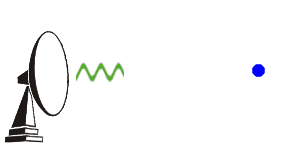 This reflected signal is so received by the radar during its listening period. Computers clarify the strength of the returned pulse, fourth dimension information technology took to travel to the object and back, and phase, or doppler shift of the pulse. This procedure of emitting a signal, listening for whatsoever returned point, then emitting the next signal, takes place very fast, up to around 1300 times each second!
This reflected signal is so received by the radar during its listening period. Computers clarify the strength of the returned pulse, fourth dimension information technology took to travel to the object and back, and phase, or doppler shift of the pulse. This procedure of emitting a signal, listening for whatsoever returned point, then emitting the next signal, takes place very fast, up to around 1300 times each second!
NEXRAD spends the vast corporeality of time "listening" for returning signals information technology sent. When the time of all the pulses each hour are totaled (the time the radar is actually transmitting), the radar is "on" for most 7 seconds each 60 minutes. The remaining 59 minutes and 53 seconds are spent listening for any returned signals.
Learn about the different scanning modes of the Radar here
The ability to discover the "shift in the phase" of the pulse of energy makes NEXRAD a Doppler radar. The phase of the returning bespeak typically changes based upon the motion of the raindrops (or bugs, grit, etc.). This Doppler consequence was named after the Austrian physicist, Christian Doppler, who discovered it. Y'all take about likely experienced the "Doppler outcome" effectually trains.
As a railroad train passes your location, yous may have noticed the pitch in the train'southward whistle irresolute from high to low. As the train approaches, the sound waves that brand up the whistle are compressed making the pitch higher than if the train was stationary. Likewise, every bit the railroad train moves abroad from you, the audio waves are stretched, lowering the pitch of the whistle. The faster the railroad train moves, the greater the change in the whistle's pitch as it passes your location.
The aforementioned effect takes identify in the temper as a pulse of energy from NEXRAD strikes an object and is reflected back toward the radar. The radar's computers measure the phase change of the reflected pulse of energy which then catechumen that change to a velocity of the object, either toward or from the radar. Information on the motion of objects either toward or away from the radar can be used to guess the speed of the air current. This ability to "come across" the air current is what enables the National Conditions Service to notice the formation of tornados which, in plow, allows united states of america to issue tornado warnings with more advanced find.

In the epitome above, the grayness line is the transmitted signal. You can see how
the returned energy changes its wavelength characteristics when it hits
a target moving abroad or toward the radar (red and dark-green line, respectively)
Now, let's await at the radar data
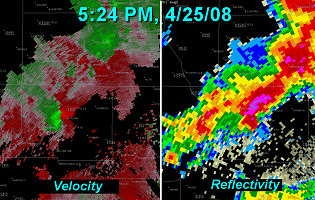
There are ii main types of data, Velocity and Reflectivity.
Reflectivity data shows u.s.a. the strength of the energy that is returned to the radar after information technology bounces off precipitation targets. Other not-precipitation targets will return free energy, but for now, we will simply deal with the precipitation. In general, the stronger the returned energy, the heavier the precipitation. Learn more nearly Reflectivity hither.
Velocity data is derived from the phase, or doppler shift of the returned energy. The radar's computers will calculate the shift and determine whether the atmospheric precipitation is moving toward or abroad from the radar, and how fast, then use a corresponding color to those directions and speeds. Red is typically a target moving away from the radar, while green is applied to targets moving toward the radar. The intensity of these colors determines its estimated speed. Learn more about Velocity hither.
In the image above, you can see the velocity data that is associated with a strong storm depicted in the reflectivity information. This is a great instance of what a tornado looks like in the velocity brandish. Click on the epitome for better detail. The radar is located to the southeast, or to the lesser right of the computer screen. Notation the bright red, or strong outbound velocities right next to the bright green, or inbound velocities. This indicates a strongly rotating column of air. When coupled with a reflectivity pattern that exhibits a hook signature, equally in this case, there is often a tornado occurring or about to occur.
Sometimes the WSR-88D Doppler Radar sees non-precipitation targets
If there is a "target" out there and it reflects radar energy back to the radar, the radar will brandish information technology equally if it was atmospheric precipitation. The radar does have some logic built in to help it discriminate between precipitation and non-precipitation targets. But, sometimes we see curious things on our radar display. Hither are a few:
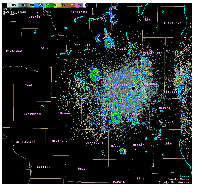 Bird Roost Rings. These are virtually common in the autumn effectually bodies of water that typically have temperatures warmer than the surrounding state at night. It is also the time birds are gathering for the seasonal migration. At night, birds remainder/nest in and effectually the lakes. Just before sunrise, in that location is often a coordinated lift off and dispersion of the birds out into the surrounding fields for feeding during the day. Click on the image to the left for a quick animation of the bird rings.
Bird Roost Rings. These are virtually common in the autumn effectually bodies of water that typically have temperatures warmer than the surrounding state at night. It is also the time birds are gathering for the seasonal migration. At night, birds remainder/nest in and effectually the lakes. Just before sunrise, in that location is often a coordinated lift off and dispersion of the birds out into the surrounding fields for feeding during the day. Click on the image to the left for a quick animation of the bird rings.
Dissonant Propagation . Based on our understanding of Radar Axle Characteristics , we expect the radar beam to exit the radar and propagate through the atmosphere in a standard way. Sometimes though, the temper will cause the beam to superrefract or duct through the atmosphere. When this happens, the beam will sometimes bend downwardly causing some of the radar energy to hitting the ground and render energy dorsum to the radar, generating Anomalous Propagation (AP). The three images above prove an interesting example. In the first prototype on the left, the circled area shows isolated AP. The centre epitome is a terrain map of southern Wisconsin. The paradigm on the correct shows the AP overlaid on the terrain map. Note how the high terrain of the Baraboo hills is highlighted past the radar. We know this is AP since we confirmed through satellite and other observations that skies were articulate.
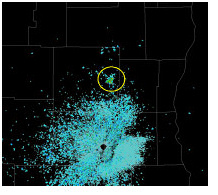 Wind Farm Interference. Current of air farms can touch Doppler radars in three ways if the turbine blades are moving and they are within the radar's line of sight. If close enough (within a few kilometers) they tin can partially block a significant percentage of the beam and attenuate data down range of the wind subcontract. They can too reflect energy back to the radar and appear as clutter (AP) on the radar paradigm and contaminate the base reflectivity data. The reflectivity data is used by radar algorithms to estimate rainfall and to detect certain storm characteristics. Finally, they tin can impact the velocity data, which are as well used past radar operators and by a variety of algorithms in the radar'south data processors to discover certain storm characteristics, such as mesocyclones, relative tempest motion, turbulence, etc. Acquire more here.
Wind Farm Interference. Current of air farms can touch Doppler radars in three ways if the turbine blades are moving and they are within the radar's line of sight. If close enough (within a few kilometers) they tin can partially block a significant percentage of the beam and attenuate data down range of the wind subcontract. They can too reflect energy back to the radar and appear as clutter (AP) on the radar paradigm and contaminate the base reflectivity data. The reflectivity data is used by radar algorithms to estimate rainfall and to detect certain storm characteristics. Finally, they tin can impact the velocity data, which are as well used past radar operators and by a variety of algorithms in the radar'south data processors to discover certain storm characteristics, such as mesocyclones, relative tempest motion, turbulence, etc. Acquire more here.
 Sun Interference. Twice a twenty-four hour period, at sunrise and sunset, the radar experiences interference from the electromagnetic energy emitted by the sun. There is a betoken at sunrise and sunset where the radar dish points straight at the sunday and is hit with this energy. This is then displayed as a spike of returned energy on our display. It is brief, typically only occurring during one volume scan. Notice in the prototype to the left that dusk is slightly southward of due w. The date is March 11, 2009. In less than 2 weeks, we volition be at the Leap Equinox. The sun volition ready due westward of the radar.
Sun Interference. Twice a twenty-four hour period, at sunrise and sunset, the radar experiences interference from the electromagnetic energy emitted by the sun. There is a betoken at sunrise and sunset where the radar dish points straight at the sunday and is hit with this energy. This is then displayed as a spike of returned energy on our display. It is brief, typically only occurring during one volume scan. Notice in the prototype to the left that dusk is slightly southward of due w. The date is March 11, 2009. In less than 2 weeks, we volition be at the Leap Equinox. The sun volition ready due westward of the radar.
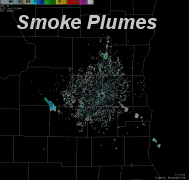 Fume Plumes . During dry periods, when there is controlled called-for or uncontained wildfires going on, our radar will detect smoke plumes associated with the fires. Many of the big smoke plumes are from prescribed, or controlled burns. These are fires intentionally set by Federal/State/Local officials for state direction purposes. Other fires may be on private lands. The two plumes in this case (click on image for an animation) were prescribed burns past the Wisconsin DNR.
Fume Plumes . During dry periods, when there is controlled called-for or uncontained wildfires going on, our radar will detect smoke plumes associated with the fires. Many of the big smoke plumes are from prescribed, or controlled burns. These are fires intentionally set by Federal/State/Local officials for state direction purposes. Other fires may be on private lands. The two plumes in this case (click on image for an animation) were prescribed burns past the Wisconsin DNR.
How Is Doppler Radar Used In Meteorology?,
Source: https://www.weather.gov/mkx/using-radar
Posted by: wilsonpriphy1953.blogspot.com


0 Response to "How Is Doppler Radar Used In Meteorology?"
Post a Comment